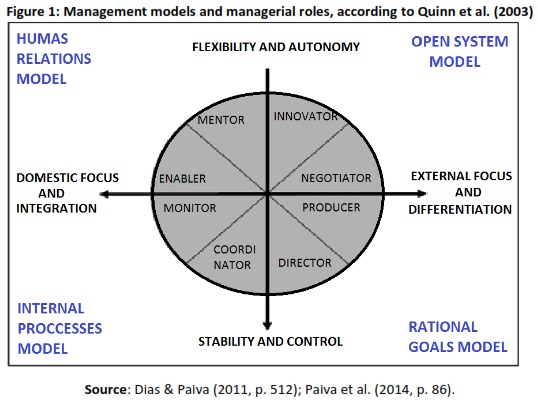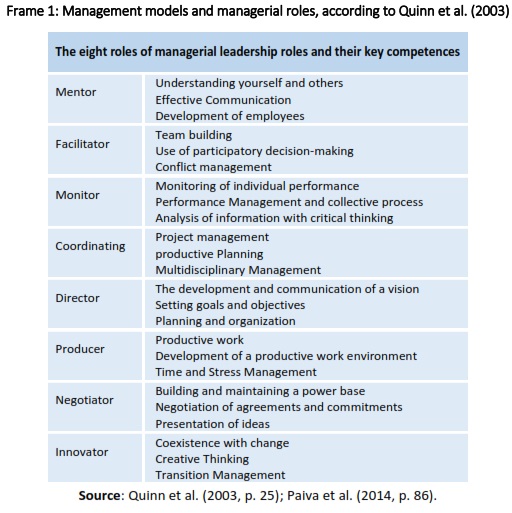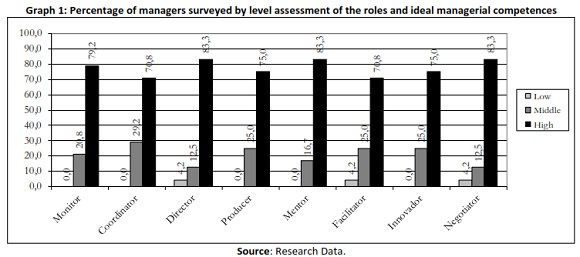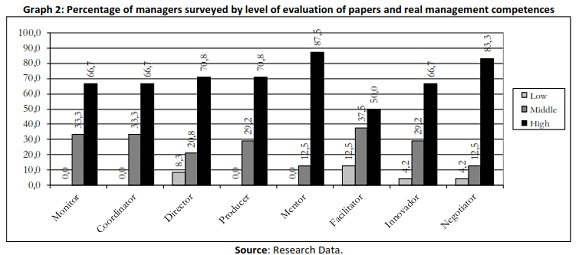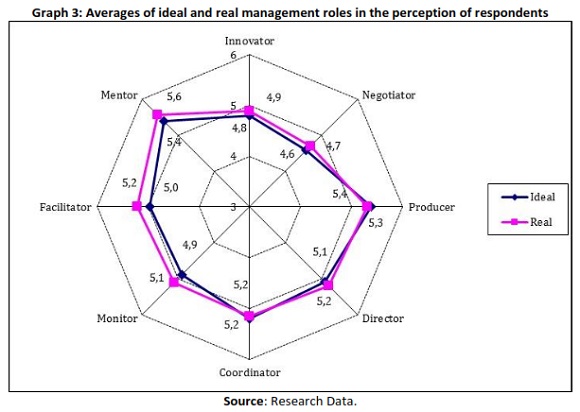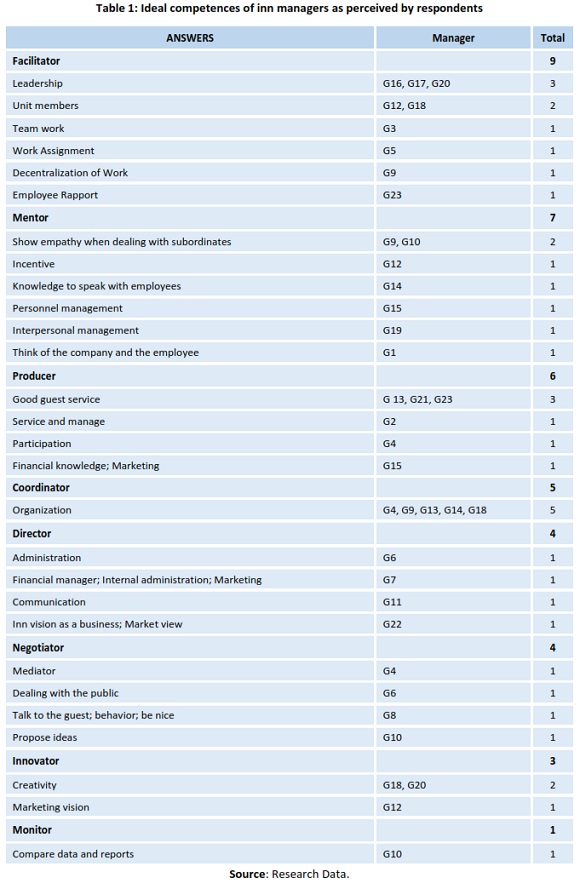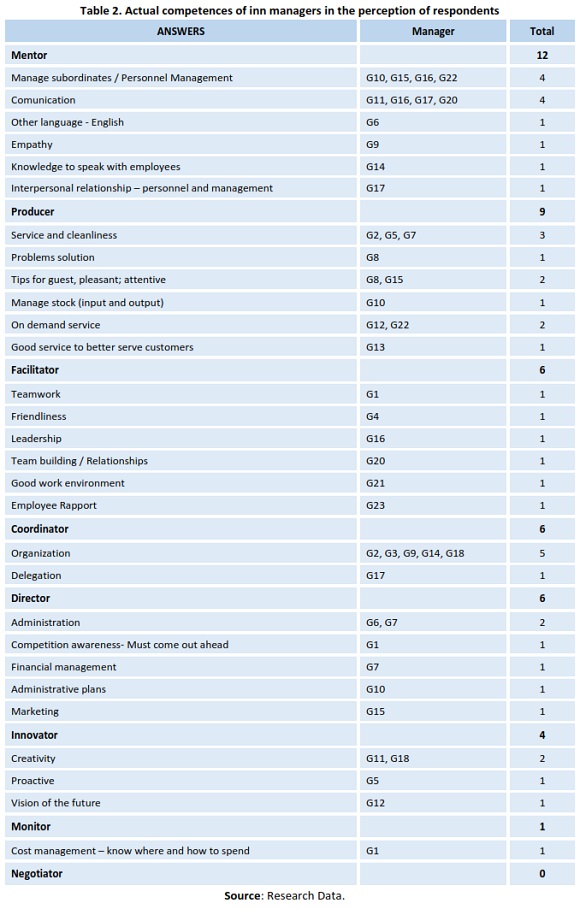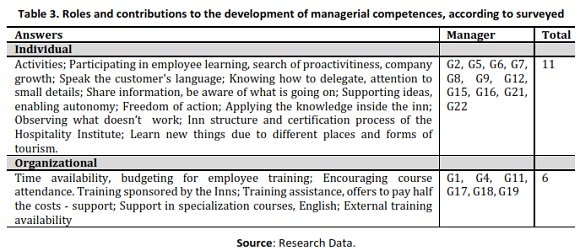Serviços Personalizados
Journal
Artigo
Indicadores
-
 Citado por SciELO
Citado por SciELO -
 Acessos
Acessos
Links relacionados
-
 Similares em
SciELO
Similares em
SciELO
Compartilhar
Tourism & Management Studies
versão impressa ISSN 2182-8458versão On-line ISSN 2182-8466
TMStudies vol.13 no.2 Faro jun. 2017
MANAGEMENT: SCIENTIFIC PAPERS
Managerial competences and their management: a study in Brazilian inns of a historic city (Tiradentes, Minas Gerais)
Competências gerenciais e sua gestão: um estudo em pousadas de uma cidade histórica brasileira (Tiradentes, MG)
*Leandro Eduardo Vieira Barros, ** Kely César Martins de Paiva, *** Mônica Carvalho Alves Cappelle
*Universidade Federal de Lavras, Brasil, leandro.barros@ifsudestemg.edu.br
**Universidade Federal de Minas Gerais, Brasil, kelypaiva@face.ufmg.br
***Universidade Federal de Lavras, Brasil, edmo@dae.ufla.br
ABSTRACT
Tourism has become prominent on the national scene, both for national authorities and society. In this environment, the hotels' branch manager plays a key role in which managerial competences are required to manage the project and the provision of services. For this reason, the objective of this research was to identify and analyze the management competences of hotel managers in Tiradentes (Minas Gerais, Brazil). For that, a field research with descriptive, qualitative and quantitative approach was carried out. It was observed that inns are family-owned businesses with little training in the area and the main role of managers is to be a mentor, focusing on human relationships. The inns contribute to the management of competences process, which occurs mainly due to an individual's daily action in the organization, also as with formal training incentives. Finally, we present the research limitations and suggestions for future research.
Keywords: Managerial competences; Management of competences; Inns; Professional competences.
RESUMO
O turismo se tornou proeminente no cenário brasileiro, tanto para as autoridades nacionais e quanto a sociedade. Neste ambiente, os gestores da hotelaria desempenham um papel fundamental no qual competências são necessárias para gerenciar o projeto e a prestação de serviços. Por esta razão, o objetivo desta pesquisa foi identificar e analisar as competências gerenciais de gestores de pousadas em Tiradentes (Minas Gerais, Brasil). Para isso, uma pesquisa de campo com abordagem descritiva, qualitativa e quantitativa foi realizada. Observou-se que as pousadas são empresas familiares, cujos gestores têm pouca formação na área e seu principal papel é ser um mentor, concentrando-se nas relações humanas. As pousadas também contribuem para a gestão das competências profissionais, o que ocorre principalmente devido à ação diária do próprio indivíduo na organização, assim como com incentivos à formação formal. Por fim, limitações da pesquisa e sugestões para futuras investigações foram apresentadas.
Palavras-chave: Competências gerenciais, pousadas, competências profissionais.
1. Introduction
Tourism has been gaining momentum in recent times in Brazil, mainly since the publication of Tourism Law no 11,771, in 2008, which laid out over the National Tourism Policy in regards to planning, development and stimulus of the sector (Brazil, 2008). In 2009, the federal government has demarcated 276 tourist regions of Brazil in 3,635 municipalities (MTur, 2009). One such region is the Trail of Inconfidentes, historically known by the coming of the Mineira Conspiracy, and that covers 20 municipalities, including the city of Tiradentes, in Minas Gerais (MG) (Brazil, 2013).
Tiradentes is part of the Royal Road Circuit, one of the largest in the country, ranging from Minas Gerais to the coast of Rio de Janeiro. The city is one of the most important of the "old way's” gold route, the slaves and the history of the area, surrounded by beautiful natural scenery, friendly people, and especially with some already established touristic infrastructure (Instituto Estrada Real, 2013), which included decades of hosting of artistic and gastronomic events at a national level.
Initially, the above-mentioned path connected the old Vila Rica, today known as Ouro Preto, to the Paraty port. However, the Portuguese crown realized the need for a safer and faster route to the Rio de Janeiro port, bringing about, in the eighteenth century, other trails to transport Brazilian gems: "the new way". Other stretches were part of the same circuit since, with the discovery of precious stones in the Serro region, the road was extended to the Arraial do Tejuco village - today known as Diamantina - giving rise to the " diamonds' path". There is also the Sabarabuçu path, created as an alternative route between the “diamonds' path” and the city of Ouro Preto. Thus, the "old", "new", "Diamonds" and " Sabarabuçu" paths converging in Ouro Preto make up the Royal Route, considered a historical route, a ”must-see” destination in the Brazilian tourism (Instituto Estrada Real, 2013).
It should be noted that Tiradentes is a city with many tourist attractions like the train ride to the city of São João del Rei, visits to the baroque churches and imperial mansions, as well as abundant local handcrafts. At the same time, the city presents itself in a secure, tranquil, hospitable way with high quality gastronomy (Instituto Estrada Real, 2013). It is important to note that in 1938 it was declared a Historical District by the Institute of Historical and Artistic Heritage, IPHAN.
This is only possible by a joint action of the government, via town hall, with the private sector, through ventures in hotel, food and entertainment services, whose management is critical to maintaining the recognition and appreciation standards obtained by the city. However, businesses administration in Brazil is extremely complex for many reasons, among them the tax burden, the difficulty of training, and retention of labor, all of them essential when providing tourist services. In this way, more and more competences are being required of the professionals that manage such enterprises, who are usually limited and small in many ways.
In this sense, Carvalho, Silva and Zago (2011) list the following as competences needed by managers of hotels and Inns: effective communication, interpersonal relationships, networking, flexibility, creativity, knowledge of other languages, understanding of market trends and products and services quality. In this way, the manager function has become more complex due to organizational changes, involving review of attitudes and practices. According to Pantuffi & Alves (2012), the competences of hospitality managers are: the ability to work in teams, behavioral, cultural and social aspects, strategic management, business view and entrepreneurship.
On the other hand, the training of Tourism Specialists in Brazil is governed by the National Curriculum Guidelines for the Undergraduate Course in Tourism (MEC, 2006), where the set of competences to mold these professionals is specified and that, in summary, they refer to the different natures of the tourism market, its expansion and management, as well as decision-making based on flexibility and adaptability (MEC, 2006).
However, the formation and development of professional competence does not happen away from the practical aspect and it especially does not happen easily, as they differ from qualification: the latter refers to "what the individual should be capable of doing" (Paiva, Santos & Lacerda, 2014, p. 84), while competence can only be assessed after the action, as it also implies recognition and appreciation of the results by both the individual and by third parties (Paiva & Melo, 2008; Paiva, 2013; Paiva et al., 2014).
Given the importance of tourism in Tiradentes to the regional economy and the demand for managerial competences in businesses related to this activity in the city, a research was carried out in order to identify the competences of managers in inns and analyze how their management take place. This proposition follows one of the suggestions set out on a research by Paiva (2013) and Paiva et al. (2014), and therefore adhering to a broader agenda.
2. Conceptual References
This session is divided into three parts, namely: Professional competences, Management competences according to Quinn et al. (2003), and Management of competences.
2.1 Professional competences
For Steffen (1999), Le Boterf (2003) and Carvalho et al. (2011), there is no single concept of competences but different perspectives that can enrich the term that is being coined. According to Brandão (2006) and Carvalho et al. (2011), it is a multifaceted concept, with different philosophical, pragmatic and epistemological perspectives. Fidalgo and Fidalgo (2007) state that, due to recent and growing changes in the working world, the issue remains on the agenda in the field of organizational studies.
Dutra, Hipólito and Silva (2000, p.162) defined competence as "the skillset or key features, that advocates any person to have superior performance in certain job or situation". According to these authors, as well as for Ruas (2001), a skillset precedes and sustains the action, which is to know-what and know-how, along with gathering knowledge in different contexts. As Le Boterf (2003, p. 38) states, "the power is revealed more in the knowing how to act than in the" know-how "itself," where as having knowledge and skills does not make a competent professional, but knowing how to mobilize them or act under a specific situation, in order to generate significant results for different audiences, beyond the subject itself. In this context, according to Retour (2008, p. 287) competence can be summarized as "a valid operational know-how".
Therefore, the ability to generate expected results (output) within the organization's objectives bases itself on knowledge previously acquired (input) (Dutra et al., 2000; Fidalgo & Fidalgo, 2007). According to Fleury (2002, p. 55), competence is a "know how to act responsibly and authentically; and it also implies to mobilize, integrate, transfer knowledge, resources, and skills that adds economic value to the organization and social value to the individual."
Observing both the process of training and development as well as its effective outsourcing in action, professional competence can be conceptualized "as an unique and productive goal-meeting way of competencies composed of varied knowledge" (Paiva & Melo, 2008, p. 349), that is, the mobilization of knowledge in order to externalize its cognitive, functional, behavioral, ethical and political components, with its results being recognized by the individual and by others (community and society) (Paiva et al., 2014, p. 85).
This concept covers process and results, which is substantially the work of the manager, since its objectives can only be achieved through the work of others, hence the importance of efforts in the coordination of the team (Hill, 1993; Motta, 2007). In the hotel sector, Carvalho et al. (2011) highlight the importance of communication and teamwork among different sectors. Pantuffi & Alves (2012) add the technical competence, business strategy, planning and results management, flexibility and attention to guests. Thus, attention to guest becomes important, because what is provided is the quality or non-quality of the service.
Besides, depending upon the context that the organization faces and the management model that it adopts, other competences will be required for the achievement of the results defined by the organization. The managerial competence model by Quinn, Faerman, Thompson and McGrath (2003) contributes to the understanding of this perspective.
2.2 Management competences according to Quinn et al. (2003)
According to Quinn et al. (2003), the surrounding in which the organization is inserted may require from it different levels of flexibility and control, as well as prioritizing focus on internal or external environment. These four extremes from two continuums define four management models, which can be understood as follows:
a) In the "rational goals" model, the goal of the organization is productivity, profit; in order to do so, managers should make explicit goals and base their performances in rational analysis, external focus action-taking and differentiation, as well as to consider stability and control. In this model, the manager roles can be a director or a producer;
b) In the "internal processes" model, the organization's goal is to become routine, hence the need for managers to define responsibilities and follow the hierarchy, focusing on the internal environment and on achieving integration, stability and control. Here, their role can be a monitor or a coordinator;
c) In the "human relations" model, the organization's goal is to develop commitment, and therefore the managers act fostering cohesion and morale, promoting conflict resolution, focusing on flexibility and autonomy, with internal focus and integration; their roles would be a mentor or a facilitator;
d) In the "open systems" model, the organization's goal is to work with adaptability; thus, the manager should strive for innovation, encouraging creativity and flexibility, focusing on flexibility and autonomy and the organization's external surroundings, acting as an innovator or a negotiator.
The poles and managerial roles of the model can be seen in Figure 1.
To act on each role, the manager needs three specific competencies, as set out by Quinn et al. (2003). Competences are not mutually exclusive, but usually prevail in the manager's daily life, indicating the role or roles they usually play in their work. Thus, Carvalho et al. (2011) highlight the mobilization and combination of a set of competences. The description of the competences of each role is set out in Frame 1.
On the chances of success and failure of managers, Quinn et al. (2003) defined ineffective management profiles: chaotic adaptive - emphasis in the roles of facilitator, mentor, innovator and producer; annoying coordinators - larger scale in the monitor and coordinator role and smaller scale in the director role; sweltering workaholics - emphasis only to the producer role; extreme unproductive - homogeneous levels in lower scale of performance in the eight roles. Effective profiles were also defined: aggressive achiever - the lowest level in facilitator role; conceptual producers - the lowest level for the monitor role; peaceful aggregators - lower levels for negotiator and producer roles; Masters - homogeneous levels in the eight roles, in which exercise of the certain roles are more or less common (Quinn et al., 2003; Paiva et al., 2014).
Thus, Quinn et al. (2003) point out that, to be a competent manager, the professional must have insight into the most appropriate role in a given situation, or management model, as well as have the ability to merge and balance different roles according to their demands. From this, their competence management arises in a way of continuous improvement that allows its outsourcing and recognition. According to Lopes et al. (2010) these competences are best employed in the organization when there is an environment that offers conditions to apply them. In this way, managers should effort in various roles in the achievement of organizational objectives.
In an analysis of the model of Quinn et al. (2003), Santos & Honorius (2014, p 656) highlight that it is possible to "monitor the development of management competences in line with the development of administration, following the historical cycle of management theory and suggesting that studying the topic is an important contribution to evolution of the various stages of management theory ".
2.3 Management of competences
According to Dutra (2001), laborer competences management is carried out by means of coordinated policies and practices with organizational strategy in order to achieve effectiveness. Thus, an effective management of skillsets implies maintenance of talented and competent people in the organization, being characterized as a differentiating factor from their competitors (Brandão & Guimarães, 2001; De Ré & De Ré, 2010).
Along the same lines, Brandão and Guimarães (2001) state that people management must develop and implement integrated policies with each other, the values of all the organization's managers and the interests of the staff to ensure that management practices are consistent with established personnel policies (De Ré & De Ré, 2010).
This integration takes place at every level of "traditional" functions of human resources management, from recruitment to displacement (De Ré & De Ré, 2010). However, some of these functions become more complex under the aegis of competence, such as the remuneration (Dutra, 2004) and the evaluation of performance (Wittorski, 2004).
Therefore, the presence of gaps are common in this management process, resulting in differences between the competences required by the organizations and the workers' competences, becoming necessary to strengthen the process through continuous learning (Dutra, 2004; De Ré & De Ré, 2010). All these actions are decided and implemented under the leadership of managers of these organizations, hence the importance of conceiving them (the managers) as the subject and author of their own story (Chanlat, 1996) and, after all, they are responsible for developing a model of competences management and interaction between individual, collective and organizational levels (Froehlich, 2010; De Ré & De Ré, 2010).
Wittorski (2004) sets out five ways to develop competences, namely:
a) Action logic: refers to the hands-on training model at work, by trial and error of new competences in action;
b) Reflection and action logic: refers to the alternating training, that is, an integration of theoretical knowledge from the classroom and the development of competences in the field of practice (internship, as an example);
c) Reflection logic over the action: corresponds to the analysis of situations of practices in organizations and is summarized in transforming implied acquired action competences (hands-on) into action knowledge (competences become transferable to others);
d) Reflection logic for action: refers to the early definition of new practices as the criteria of quality and productivity established by the workers;
e) Integration/assimilation logic: that in which theoretical knowledge absorbed in the training is incorporated into the knowledge by individuals and will result in different competences depending on the situations encountered.
Thus, competence management is not unique to the individual practice in the organization (guided by action knowledge) nor does it come solely from the academic and formal training (based on theoretical knowledge). As pointed out by Paiva & Melo (2008), the management of competences is not carried out only through formal means nor does it occur only by the worker's own action; it does, however have other social roles that affect it, such as educational institutions, the State and the organizations where the professional works or has worked.
With these conceptual references, we proceeded to a field research along the lines described below.
3. Methodology
Aimed at the general goal, a descriptive field research with quantitative (Berto & Nakano, 1999; Hair Jr, Anderson, Tatham & Black, 2005) and qualitative (Flick, 1995) approaches took place, featuring a triangulation of methods (Hussey & Collis, 2006). The field of research (Marconi & Lakatos, 2005) took place in the city of Tiradentes (Minas Gerais, Brazil), in particular with managers of its inns, whose data were handled with breadth and depth (Triviños, 1987; Bryman, 1989).
To collect data, it was elaborated a questionnaire that included socio-professional data, four essay questions, in order to deepen the insights of the subjects on the ideal and real and real competences in the exercise of its function, their contributions to management and the inn contributions, and sixteen objective questions regarding managerial competences, as model of Quinn et al. (2003), investigating the required by the organization and effective managers, through a Likert scale of six points.
Respondents were selected from the website of the Tiradentes' Chamber of Commerce - Minas Gerais, ASSET (www.asset.gov.br), which contains a list of associated inns. Meetings were then scheduled and held with managers, associate directors and manager-owners. In ASSET are registered 51 inns which were visited, however, 23 managers agreed to participate. The justification for refusal relates to lack of time, not at the scheduled time, having returned later, but it was not possible to hold the meeting. However, the data met the criteria proposed by saturation Gil (1999).
In order to analyze objective responses, it was used descriptive statistics (Hair et al., 2005) following its recording in spreadsheet, and for the essay questions content analysis (Bardin, 1977). As recommended by Demo (2005), it tried to go beyond the data, interpret the meaning of words and texts, identifying the meaning in between the lines, which allowed the development of tables that summarized the answers and enabled to point out the recurrence of certain content in the reports.
4. Presentation and analysis of data
This session is divided into three parts, namely: profile of respondents, ideal and actual managerial competences, in their own perception, and management skil of those interviewed.
4.1 Profile of subjects
Regarding the profile of the 23 Tiradentes Inn managers, most are female (17 women), age up to 30 years (11 of the total), married (11 of the total), with completed secondary education (10 of them). Note that, among those with an university degree (10 of the total), only two have degrees in the hotel sector and on has a doctorate in veterinary medicine, which denotes the low-skilled managers in its line of business. In this respect, Carvalho et al. (2011) calls attention to the need to qualify these professionals from the perspective of managerial competences.
The time in office is on average 1 to 5 years (10 of the total) and the time working at the Inn is on average 1 to 5 years (13 of them). It is noticed that three managers were trained at the inn where they work, setting up an informal competences development, which charters the responsibility of the individuals themselves as well as of the organization in this process (Paiva & Melo, 2008). In addition, the development of competences in the workplace goes through the logic of trial and error and involves the "action logic" by Wittorski (2004).
Finally, only 9 managers had worked in a managerial role before, although not necessarily in an inn, which emphasizes the earlier conclusion that most are formed informally at the inn, also showing that implied competences are learned in action and transferred by other roles (Wittorski, 2004).
The inns have an average of 17 rooms with a capacity for 43 guests each. They are characterized as "family-owned” inns, as in only 9 of them the manager is an employee while in the others, the manager is the son/daughter, grandson/granddaughter, the owner's wife, and the owner himself. Most have 2 or 3 staff members for cleaning and food services.
4.2 Managerial competences: the ideal and the real, from the perspective of respondents
Basing on the model of Quinn et al. (2003), it was found that the most frequent managerial roles are that of a director (83.3%), a mentor (83.3%) and a negotiator (83.3%). There was a mix of external focus and stability while at the same time seeking differentiation, autonomy and control (Quinn et al. 2003), which shows a lack of awareness by the surveyed managers of what is required of them at the inns. The facilitator roles (70.8%) and coordinator roles (70.8%) were less recurrent. The percentages of respondents by level of analysis of each role can be seen in Graph 1.
With regard to effective management competences, a decline is seen in high-level respondents' percentage, which shows that they understand their actions falling short, a fact confirmed by Paiva et al. (2014) on managers of Brazilian inns. The mentor roles (87.5%) and negotiator roles (83.3%) are the most interpreted, while the facilitator role is the lowest figure in their daily lives (50.0%), this can be understood by the characteristics of the inns, which are family owned and operated, and with a small number of employees. Graph 2 shows these data.
Analyzing the managerial role averages for ideal and actual, it was noticed that only the monitor role remained with similar averages (5.5), while in all others the average of the actual performance was less than ideal, corroborating with the prior analysis. It is important to note that the mentor's role is made up of three competences, which are understanding of themselves and others, effective communication and employee development (Quinn et al., 2003), and these are certainly demonstrated by the characteristics of the listed inns. It also helps to understand the shyness of the facilitator role (average 4.9 on the ideal and the real 4.5), since the competences that support them (team development, decision-making participation, and conflict management) make less sense in the kinds of ventures approached. In Graph 3, these averages can be observed.
It should be noted from the above graph, that the ideal behavior appointed by the managers is similar to that of an effective master, that is to say, performing all roles effectively and in similar frequency (Quinn et al., 2003); however, actual behavior is not similar to any of those described by Quinn et al. (2003), which will require further research in the future.
In the qualitative part of the research, the ideal competences of inn managers were asked to them. The answers that stood out the most were competences related to the action (Fleury, 2002; Le Boterf, 2003; Wittorski, 2004), that is, involving the inn activities as a differential to attract customers (all 23 managers). Another recurring response was on management activity (10 of them), followed by others to a lesser extent, such as team coordination activities, leadership and innovation.
In any case, all responses were aligned to Quinn et al. (2003)'s model and it was noticed that the result differed from the quantitative part, for the most recurring role in managers' responses was that of a facilitator (9 responses), followed by mentor (7) and producer (6); the least mentioned role was that of a monitor (1). In Table 1, one can observe all the categorized responses.
Next, the questionnaire inquired about the actual competences of inn managers. In this part, the highlight was the differential in customer service (23 managers) and management activity (12), which shows an alignment between the ideal and what really is experienced on the routine of inn managers surveyed. In addition, the said differential clearly reflects the fourth way proposed by Wittorski (2004) concerning the quality in productive actions. Specific knowledge was also mentioned (5), such as foreign language study and computer science, which is related to the need for continuous learning and development of competences (Steffen, 1999; Bitencourt & Barbosa, 2010). Other ones like managing subordinates (3), creativity and have vision of the future (3), and commitment also corroborate with this literature (Steffen, 1999; Bitencourt & Barbosa, 2010).
Following the same analysis logic, all responses were also aligned to the model of Quinn et al. (2003). The result resembled the quantitative portion, as the most recurring role in the perception of managers was that of a mentor (12 responses), followed by producer (9) and facilitator, coordinator and director (6 answers each). The role of facilitator was once again amongst the most mentioned by managers, and reasons for that could not be explained during this research. Similarly, to the above, Table 2 depicts all categorized answers.
It is noticed that the results obtained are similar to de Carvalho et al. (2011) when highlighted the importance of communication, good interpersonal competences as the main capacity developed from experience as a manager, that is, the mentor role. And the role of producer linked with the competences listed by (Pantuffi & Alves, 2012). It is observed that the negotiator role was not mentioned by any manager, when actual competences were questioned.
Finally, it can be concluded that the role most notably brought up by the managers surveyed is that of the mentor, typical of the "human relations" management model, which seeks to develop commitment by focusing on flexibility and autonomy, with internal focus and integration (Quinn et al., 2003). This result was also observed among managers surveyed by Paiva et al. (2014). However, given the emphasis in other roles, it is unwise to assert that this is the dominant model of management in covered inns. This result was also observed among managers surveyed by Paiva et al. (2014).
4.3. Management managerial competences, according to surveyed
Finally, managers were asked how they managed their competences. According to Froehlich (2010) and De Ré and De Ré (2010), the individual is partly responsible by its management of competences process, although other social means are also part of this scenario, such as organizations and other stakeholders, as stated by Paiva and Melo (2008).
The scrips themselves are as very eclectic in its formalities: from formal education (12 answers) to their daily tasks (9), this corroborates with the literature at hand (Fleury, 2002; Le Boterf, 2003; Wittorski, 2004). Therefore, the work environment has become a site for competence´s development (Dugué, 2004). The dyad of formal and informal learning was also mentioned (5 of them), exemplified by both the search for qualification in educational institutions as well as self-management activity within its competence, indicating the need for continuity of this process (Dutra, 2001; De Ré & De Ré, 2010).
In regards to the organization's contributions to the development of managerial competences, only 2 of those surveyed did not answer this question, and 4 of them stated that the organization does not participate in this process. On the other hand, 17 of them recognized the inns' contributions, linking them to the benefits of this process, and supporting the perception brought up by Brandão and Guimarães (2001) of this process bringing up possible competitive advantages and differentiators for organization as a result.
All the answers were pointed at Table 3.
In this way, the development of managerial competence is anchored in everyday practice, that is, the mobilization of knowledge in productive action and learning that takes place the action. They are supported by a set of individual actions in their work and actions incentivized by organization in the case of managers surveyed in Tiradentes inns. Similar results were found in the work of Carvalho et al. (2011). Therefore, Zago and Retour (2013) highlight the importance of these relationships between individual behavior and organization for the competences development process. And Lopes et al. (2010) evidence how relevant is the participation of the organization in the training process.
5. Conclusions
It was observed that the inns covered in this research are predominantly family-owned with few professionals with academic training in the hospitality area. This contributes to the understanding of the ideal and predominantly effected role in the daily lives of these managers, that is, the mentor, a similar result to research of Carvalho et al. (2011) and Palva et al. (2014) in hotels and inns in Brazil. From the adopted model was possible to identify the role of mentor to the "human relations". Other roles are also effected in a particular way, which enabled the identification of a profile of peaceful aggregators managers, along the lines proposed by Quinn et al. (2003). In Paiva et al. (2014) the result approached the same profile presented in this study. Regarding the signaling for human relationships, similar results were found in the work of Dimmock, Breen & Walo (2003) conducted in Australia in tourism and hospitality, in which interpersonal and relationships competences, understanding of others professionals and communication were highlighted.
In either case, the possibility of such management model being what prevails in the surveyed inns in Tiradentes was not excluded, since this model seeks the people's commitment, which is usual in family enterprises through more emotional ties, just as the managerial focus is the vis-à-vis internal integration in order to deal with market demands, and this suggest a lack of management autonomy when in need to make quick decision. This can be recognized as the difference between the means of ideal and actual roles and therefore there is a possibility of improvement in the performance of these managers.
On the other hand, the facilitator and innovator roles were the ones least evaluated by the ones surveyed. The first considers the following competences: team building, usage of decision-making process and conflict management, all of which were notably recognized in the qualitative part of the research. The second role, the innovator, is based on the following competences: transition adaptability, creative thinking, and change management. As a matter of fact, considering that the city was declared a heritage nearly 80 years ago and is known for its art and gastronomy, one would expect that this role would more frequently be observed in the conduct of the inn managers. This is another point that needs further clarification in future research.
As for management competences, the findings herein support similar literature within Brazil, where such a process usually is concentrated on the hands of the professionals themselves, and eventually with the organization where they work. Other social roles that could be present, such as educational institutions and institutions of collective interest (associations, unions, councils, etc.), are not perceived by the surveyed managers, which, incidentally, do not have and mostly specific training in Tourism and Hospitality area.
The contributions of this research aims to create a management profile in the city of Tiradentes, the competences they perceive as required (ideal) and actual (real) in their daily work and their process of formation and development. In addition, the methodological triangulation enabled an expanded analysis of the managerial competences, indicating commonalities between the results of quantitative and qualitative approaches as well as disparate points, considered more interesting and fruitful for future research because they incite elucidation.
Within the extent of the research, it was observed that, during the data collection, many managers had to stop filling out the questionnaire to resolve problems at their inns and/or meet with guests. Others were not at the inn at the scheduled time. Added to these, those who refused to participate, explaining that they had no time to answer the questionnaire. Also, it is important to consider the peculiarity of the "historic" city, what indicates the need to enlarge the research to similar cities in order to expand and deepen the description of this management “style”, which can be very useful for managers themselves, as well as the development of public policies for its improvement.
Finally, in addressing the managers, it is suggested they pay attention to the competences and to the dilemmas and challenges involved in their management style, which includes a more specific academic training in the field of hospitality and tourism. In this sense, the participation of the inn in various ways (subsidizing training in whole or in part, allocating hours to study, etc.), as well as of other social institutions already mentioned, can be a safer way to develop competitive advantages in such ventures. This includes a professionalization of the inn management, which is currently predominantly family focused.
REFERENCES
Associação Empresarial de Tiradentes - ASSET. (2013). Retrieved 02/05/2013 from http://www.asset.org.br/index.php?secao=associados&acao=segmento&id_cat=2 [ Links ]
Bardin, L. (1997). Análise de conteúdo. Lisboa: Edições 70. [ Links ]
Berto, R.M.V.S. & Nakano, D.N. (1999). A Produção Científica nos Anais do Encontro Nacional de Engenharia de Produção: um levantamento de métodos e tipos de pesquisas. In: ENCONTRO NACIONAL DE ENGENHARIA DE PRODUÇÃO - ENEGEP, 19, 1999, Rio de Janeiro. Anais ENEGEP.
Bitencourt, C.C. & Barbosa, A.C.Q. (2010). Gestão de competências: articulando indivíduos, organizações e sociedade. In: BITENCOURT, C. C. (org.) Gestão contemporânea de pessoas (pp. 239-269). Porto Alegre: Brookman, 2010. [ Links ]
Brandão, H. P. (2006). Competências no Trabalho e nas Organizações: Uma Análise da Produção Científica Brasileira. In: EnANPAD, 30, 2006, Salvador. Anais... Rio de Janeiro: ANPAD.
Brandão, H.P. & Guimarães, T.A. (2001). Gestão de competências e gestão de desempenho: tecnologias distintas ou instrumentos de um mesmo construto? Revista de Administração de Empresas, 41(1), 8-15. [ Links ]
Brasil. (2008) Lei do Turismo - nº 11.771. Retrieved 04/06/2013 from http://www.planalto.gov.br/ccivil_03/_ato2007-2010/2008/lei/l11771.htm
Brasil. (2013) Portaria nº 112. Diário Oficial da União. DOU. Nº 100, p. 83.
Bryman, A. (1989). Research methods and organization studies. London: Unwin Hyman. [ Links ]
Carvalho, N.L.N., Silva, A.B. & Zago, C.C. (2011). Fatores de influência no desenvolvimento de competências gerenciais em hotéis e pousadas. Turismo - visão e ação, 13(2), 201-219. [ Links ]
Chanlat, J.F. (1996). O indivíduo na organização: dimensões esquecidas. São Paulo: Atlas. [ Links ]
Collis, J., & Hussey, R. (2006). Pesquisa em administração: um guia prático para alunos de graduação e pós-graduação. Porto Alegre: Bookman. [ Links ]
Dadoy, M. (2004). As noções de competências e competências à luz das transformações na gestão da mão-de-obra. In: Tomasi, A. (Org.). Da qualificação à competência pesando o século XXI (pp. 105-142). Campinas: Papirus. [ Links ]
De Ré, C.A. & De Ré, M.A. (2010). Processos do sistema de gestão de pessoas. In: Bitencourt, Claudia. Cristina. (org), Gestão contemporânea de pessoas (pp. 79-100). Porto Alegre: Brookman. [ Links ]
Dimmock, K.; Breen, H.; Walo, M. (2003). Management Competencies: an Australian assessment of tourism and hospitality students. Journal of the Australian and New Zealand Academy of Management, v. 9, n. 1, p. 12-26.
Demo, P. (2005). Avaliação qualitativa. Campinas: Autores Associados. [ Links ]
Dias, H.C.V.B., Paiva, K.C.M. (2011). Competências do enfermeiro: estudo em um hospital privado. Revista Brasileira de Enfermagem, 64, 511-520. [ Links ]
Dugué, E. (2004). A lógica da competência: o retorno do passado. In: Tomasi, A. (org.). Da Qualificação à Competência (pp. 16-32). Campinas: Papirus. [ Links ]
Dutra, J.S. (2001). Gestão de pessoas com base em competências. In: Dutra, J.S. (org). Gestão por competências (pp. 25-44). São Paulo: Editora Gente. [ Links ]
Dutra, J.S., Hipólito J.A.M. & Silva, C.M. (2000). Gestão de pessoas por competências: o caso de uma empresa do setor de telecomunicações. Revista de Administração Contemporânea, 4(1) 161-176. [ Links ]
Instituto Estrada Real. (2013). Retrieved 05/06/2013 from http://www.institutoestradareal.com.br/estrada-real/apresentacao
Fidalgo, N.L.R. & Fidalgo, F. (2007). Refluxos sociais da lógica de competências: o processo de individualização em foco. In: Fidalgo, F., Oliveira, M.A.M. & Fidalgo, N.L.R. (Orgs.). Educação Profissional e a Lógica das Competências (pp. 17-70). Petrópolis: Vozes. [ Links ]
Fleury, M.T.L. (2002). A gestão de competências e a estratégia organizacional. As pessoas na organização. São Paulo: Gente. [ Links ]
Flick, U. (1995). Desenho da pesquisa qualitativa. Porto Alegre: Artmed. [ Links ]
Froehlich, C. (2010). O modelo de gestão de pessoas por competências. In: Bitencourt, Claudia. Cristina (org), Gestão contemporânea de pessoas. Porto Alegre: Bookman. Texto complementar, capítulo 4 CD-ROM. [ Links ]
Gil, A.C. (1999). Métodos e técnicas de pesquisa social. São Paulo: Atlas. [ Links ]
Hair Jr., J.F., Anderson, R.E., Tatham, R.L. & Black, W.C. (2005). Análise multivariada de dados. Porto Alegre: Bookman. [ Links ]
Hill, L. A. (1993). Novos gerentes: assumindo uma nova identidade. São Paulo: Makron Books. [ Links ]
Le Boterf, G. (2003). Desenvolvendo a competência dos profissionais. Porto Alegre: Artmed. [ Links ]
Lopes, M. C, Fialho, F. A. P., Leonardi, J., Lopes, L. F, Ribeiro, S. F., & Wilhelm, P. P. H. (2010). Análise da relação entre aptidões cerebrais e competências gerenciais: o caso de uma empresa têxtil. Gestão & Produção, 17(1), 123-136. [ Links ]
Marconi, M.A., Lakatos, E.M. (2015). Fundamentos de metodologia científica. São Paulo: Atlas. [ Links ]
MEC. Ministério da Educação. (1996). In: Conselho Nacional de Educação. Lei de Diretrizes e Bases da Educação Nacional. Brasília. MEC. [ Links ]
MEC - Ministério da Educação. (2006). Resolução nº 13, de 24 de dezembro de 2006. Estabelece as Diretrizes curriculares nacionais para o curso de graduação em Turismo. Retrieved 25/05/2013 from http://portal.mec.gov.br/cne/arquivos/pdf/rces13_06.pdf [ Links ]
MTur - Ministério do Turismo (2009). Mapa de Regionalização do Turismo. Retrieved 17/12/2014 from http://www.turismo.gov.br/export/sites/default/turismo/programas_acoes/regionalizacao_turismo/downloads_regionalizacao/Mapa_2009.pdf [ Links ]
Motta, P. R. (2007). Gestão Contemporânea: a ciência e a arte de ser dirigente. Rio de Janeiro: Record. [ Links ]
Paiva, K.C.M. (2013). Das “competências profissionais” às “competências laborais”: modelo de análise e agendas de pesquisa. In José António C. Santos, Filipa Perdigão & Paulo Águas, Proceedings TMS Algarve 2012: Human Resources, Business Ethics & Governance, vol. 2 (pp. 502-510), Faro, Portugal: University of Algarve. [ Links ]
Paiva, K. C. M. & Melo, M. C. O. (2008). Competências, gestão de competências e profissões: perspectivas de pesquisas. Revista de Administração Contemporânea, 12(2), 339-368. [ Links ]
Paiva, K., Santos, A., & Lacerda, M. (2014). Competências gerenciais e sua gestão na hotelaria: um estudo com gestores brasileiros. Tourism & Management Studies, 10(2), 84-93. [ Links ]
Pantuffi, C. M. & Alves, R. A. (2012). Bacharelado em Hotelaria: pequenas recordações que constroem sua trajetória. Anais do Fórum de Operadores Hoteleiros do Brasil - FOHB, Senac, São Paulo. [ Links ]
Quinn, R.E., Faerman, S.R., Thompson, M P., & McGrath, M. (2003). Competências Gerenciais: princípios e aplicações. Rio de Janeiro: Elsevier. [ Links ]
Retour, D. (2008). Progressos e Limites da Gestão por Competência na França. In: DUTRA, J. S.; FLEURY, M. T. L.; RUAS, (org.) Competências: conceitos, métodos e experiências. Atlas, São Paulo.
Ruas, R. (2001). Desenvolvimento de Competências Gerenciais e Contribuição da Aprendizagem Organizacional. In: Fleury, M.T.L., Oliveira-Jr, M.M. (Orgs.) Desenvolvimento de competências gerenciais (pp. 242-270). São Paulo. Atlas. [ Links ]
Santos, E. P. & Honório, L. C. (2014). Competências gerenciais em uma rede mineira de farmácias. Revista Alcance, 21(4), 650-673. [ Links ]
Steffen, I. (1999). Modelos de competência profissional (mimeo). São Paulo: Universidade de São Paulo. [ Links ]
Triviños, A.N.S. (1987). Introdução à pesquisa em ciências sociais: a pesquisa qualitativa em educação. São Paulo: Atlas. [ Links ]
Zarifian, P. (2001). Objetivo competência. Por uma nova lógica. São Paulo. Atlas. [ Links ]
Wittorski, R. (2004). Da fabricação das competências. In: Tomasi, A. (Org.). Da qualificação à competência pesando o século XXI (pp. 75-92). Campinas. Papirus. [ Links ]
Acknowledgements
The authors thank IF Sudeste MG for its financial support.
Received: 10.06.2016
Revisions required: 12.07.2016
Accepted: 12.11.2016













